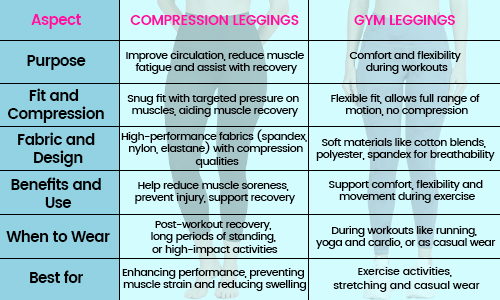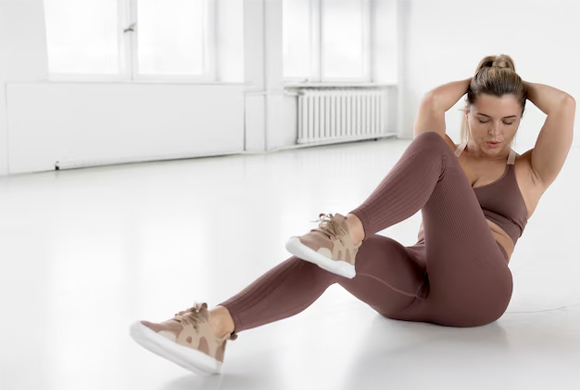Confused between compression leggings and gym leggings? Let’s break down their differences and help you choose the right one for your fitness routine.
Understanding the Key Differences

While both compression leggings and gym leggings serve different purposes, knowing their unique features helps you choose the right one for your needs. Now, let's dive deeper into what wearing compression leggings and gym leggings means for your fitness journey.
What If?
Yes, I am Wearing Compression Leggings
Compression leggings are designed to improve circulation, reduce muscle soreness and enhance recovery. If you're already wearing them, you're likely enjoying the benefits of improved blood flow, especially after workouts or long hours of standing. These leggings apply gentle pressure to key muscle areas, which can help reduce swelling and muscle fatigue. They’re a great choice for post-workout recovery, long flights, or even just for comfort during the day if you're on your feet a lot. The tight fit ensures that muscles stay engaged and helps with muscle oxygenation.
When to Wear Compression Leggings?
Compression leggings are ideal for situations where you need added support and recovery. You should consider wearing them during:
- Post-workout recovery to reduce muscle soreness
- Long flights to prevent swelling and improve circulation
- During high-intensity sports or workouts to reduce muscle fatigue
- For everyday comfort, especially if you’re on your feet for long periods of time
What If?
No, I’m Not Wearing Compression Leggings
If you’re not currently wearing compression leggings, you might not be getting the added benefits of muscle support and enhanced circulation. Regular leggings, though comfortable for the gym and daily wear, don’t provide the same level of support as compression leggings. However, if your goal is more about comfort, flexibility, or casual style, you can choose leggings that are less tight and provide more freedom of movement.
When to Wear Gym Leggings?
Gym leggings are made with stretchy, breathable materials designed for active movement. Unlike compression leggings, they aren’t designed for muscle recovery or circulation, but for providing comfort and freedom during exercise. You should wear gym leggings during:
- Intense workout sessions like cardio, weight training, or yoga
- Running or high-movement activities where comfort and flexibility are key
- Light to moderate exercises where breathability and mobility matter most
Best Compression Leggings for a Workout
Compression leggings are a popular choice for enhancing workout performance and speeding up recovery.
1. Material
Compression leggings should be made of nylon, spandex, elastane, or polyester. These fabrics are known for their excellent stretch, breathability, and moisture-wicking properties. They help to keep your body dry and comfortable by pulling sweat away from the skin. Look for leggings with a smooth, high-stretch fabric that fits closely without causing discomfort.
2. Compression Level
Compression leggings come in different pressure levels. Opt for medium compression leggings for most workout routines. They’ll offer support without being too restrictive. If you’re focusing on recovery, high compression leggings can help speed up muscle repair and minimize soreness.
3. Fit
Compression leggings should offer a snug yet flexible fit. Look for seamless designs or flatlock seams to minimize chafing. The high-waisted fit ensures the leggings stay in place, providing stability and support around your core while working out.
4. Breathability and Ventilation
Good compression leggings are breathable and allow for airflow to prevent overheating. Look for leggings with mesh panels or ventilated areas. This will allow your skin to breathe, especially during high-intensity exercises or hot weather.
5. Mobility
Leggings should allow for a full range of motion. Check for 4-way stretch fabric, which ensures that the leggings stretch in all directions to support flexibility in movements like squats, lunges, or stretches.
6. Durability
Compression leggings should withstand rigorous workouts without losing their elasticity. Choose leggings made from durable, abrasion-resistant fabrics that maintain their shape over time. Reinforced stitching can also improve durability, especially if you do a lot of high-impact activities.
Compression leggings are great for recovery and muscle support, while gym leggings offer flexibility and comfort for active workouts. Choose the right one based on your needs.
FAQs
- Are compression leggings good for gym?
Yes, compression leggings help support muscles, improve circulation, and reduce soreness during high-impact workouts.
- What is the difference between leggings and compression leggings?
Leggings are made for comfort and style, while compression leggings provide targeted pressure to improve circulation and support muscle recovery.
- Should I wear compression when working out?
Yes, compression leggings can enhance performance by providing muscle support and reducing fatigue during intense exercises.
- Is it okay to wear compression leggings all day?
Wearing compression leggings all day is safe for recovery or long standing periods, but avoid wearing them continuously for comfort.
- What are the disadvantages of compression clothing?
Compression clothing may cause discomfort, restrict movement, or lead to skin irritation if worn too long or too tight.
- How long do you wear compression leggings after a workout?
Wear compression leggings for 1 to 2 hours after a workout to aid recovery and reduce soreness.

